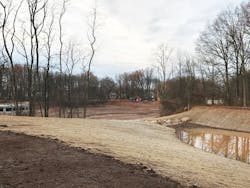Building Up Bluebelt
Staten Island, one of the five boroughs of New York City, was hit particularly hard by Hurricane Sandy in 2012. While the devastation of the storm made headlines around the country, even the most routine rainstorms passing over many parts of Staten Island caused considerable flooding of homes, businesses and streets. The New York City Department of Design and Construction (DDC) has been intensely involved in addressing this ongoing problem with design solutions and construction projects that bring needed drainage infrastructure to those areas suffering from flooding caused by common storms.
One design solution that has successfully been brought into construction is the Staten Island Bluebelt program. The Bluebelt is an ecologically sustainable storm water management system that DDC is implementing for its client agency, the NYC Department of Environmental Protection (DEP). The program preserves natural waterways and drainage features such as streams, creeks, ponds and wetlands. Preservation and careful engineering of these wetland systems forge new ways for water to be diverted from streets and sidewalks, ultimately reducing instances of flooding and ponding when it rains.
The Bluebelt areas filter and store storm water, delaying the flow in order to reduce the peaks in flooding downstream. Additionally, the linear Bluebelt land systems provide important community open spaces and diverse wildlife habitats.
Sheldon Avenue Project
The largest expansion to date of the Staten Island Bluebelt is an undertaking known as the Sheldon Avenue project in the New Creek Bluebelt. This $48 million project, which includes storm and sanitary sewer construction as well as Bluebelt development, is currently being managed by DDC for DEP. Construction of the Sheldon Avenue drainage project began in March 2014 and is expected to be completed in fall 2017.
The project encompasses the installation of a new storm sewer system almost 3 miles long that will collect storm water from local streets and direct it to a new wetland area being built on New York City-owned Bluebelt land at the east end of Sheldon Avenue. The wetland connects to the existing Annadale Wedge Pond, a man-made storm water retention pond that is being expanded with new wetlands and step pools. The step pools will be underlain with porous material that will encourage infiltration of some storm water flows into the ground. Silt fences and other sediment control measures are in use during construction to prevent runoff into nearby water features.
Over the past several decades, residential and commercial development on Staten Island far outpaced the construction of new sewer infrastructure. The neighborhood to be served by the drainage system under the Sheldon Avenue project did not have any storm or sanitary sewers, so the project will deliver much needed separate storm and sanitary sewer systems. The storm sewers will drain into the man-made wetland created to improve water quality and lessen downstream flooding. The installation of storm sewers and Bluebelt features in the Sheldon Avenue area aids in bringing a more sustainable and resilient future for New York City.
The entire area is at the head of the Sweet Brook Bluebelt system that eventually drains downstream into Richmond Creek and the Arthur Kill. Almost 200 new catch basins also will be added to local streets to help capture storm water at individual locations. The catch basins will allow precipitation to drain from the roadways into the new storm sewers, which then will direct it to the Bluebelt wetland, where it will be filtered naturally to protect the environment.
More than 4 miles of new sanitary sewer in the vicinity of Sheldon Avenue will allow almost 600 homes in the community to discontinue the use of septic systems that can leach wastewater into the local environment. The project also is replacing 2.2 miles of old cast iron water main with modern ductile iron water main. In-house engineers at DDC designed the sewer and water main systems. The work also includes the planting of more than 700 trees, tens of thousands of plants and wildflowers, and more than 100,000 sq ft of grass seeding. Additionally, the installation 133 manholes under the purview of the Sheldon Avenue project will help DEP operate and maintain the new drainage system.
An all-pipe network for managing storm water, such as the infrastructure found across New York Harbor in Manhattan, would have destroyed existing wetlands. The Bluebelt program, and by extension the Sheldon Avenue project, instead use existing drainage corridors and wetlands as a natural conduit to divert storm water from streets.
Wetland restoration is another key component of the project. Degraded wetlands rife with non-native and invasive species will be restored, which is important, as wetlands play a vital role in helping to make the community more resilient for a future that may bring heavy rain storms due to altered climate conditions.
Risk Management
The project team undertook a comprehensive assessment of potential risks and impacts to existing wetlands, and took steps to mitigate damage to the natural environment. The enhancement of an existing man-made storm water pond with extensive new wetland plantings in order to create a storm water best management practice, was included as part of this project and is expected to have a significant positive impact on wildlife by restoring a natural area.
Over the past 10 years, DDC and DEP have completed many Bluebelt projects. The Bluebelt system as a whole drains approximately one-third of Staten Island’s land area. In the South Richmond and mid-island areas, the city has purchased approximately 400 acres of wetland property for Bluebelts that provide drainage for 19 watersheds, covering about 14,000 acres.


